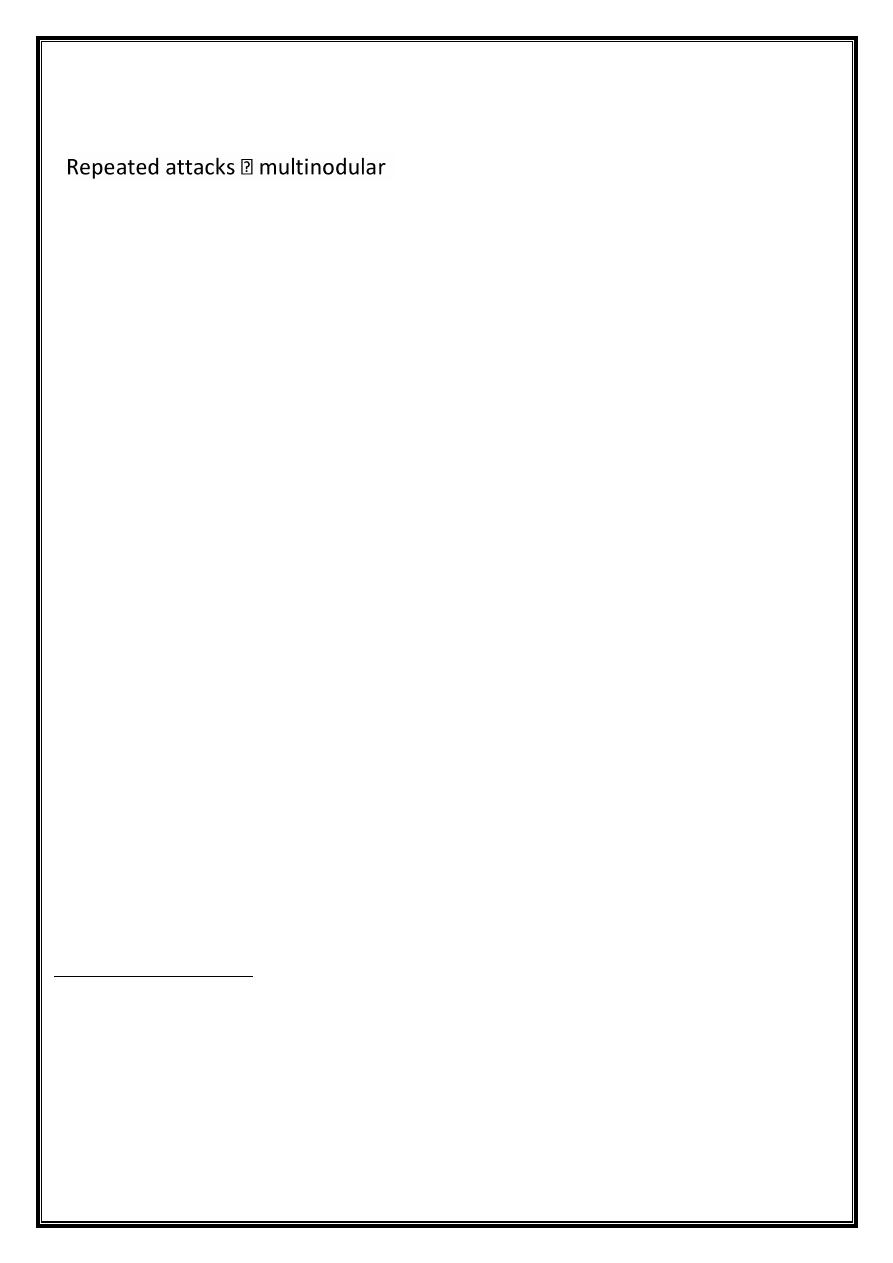
1
Disorders of Thyroid
Hyperthyroidism
-
Hypothyroidism
-
Thyroiditis
-
Diffuse multinodular Goiter
.
-
Neoplasms – adenoma/carcinoma
.
-
Congenital – Thyroglossal cyst/duct
.
-
Goiter
It is a diffuse or focal enlargement of the thyroid gland
.
Caused by: 1- Colloid goiter. 2- Grave’s disease. 3- Thyroiditis. 4- Tumors
.
Colloid goiter
most cases start as diffuse enlargement with nodularity development at later
stages
.
They represent compensatory hyperplasia of follicular epithelium
secondary to decreased thyroid hormone production
.
Diffuse-Multinodular goiter
Pathophysiology
:
Endemic & sporadic types
-
Endemic: Cassava – thiocyanate – iodide transport
-
.
- Sporadic: rare, females, young and usually of unclear cause. (may be
associated mild defect, iodine deficiency and physiological needs
.)
- When there is low T3 and T4 there will be an increase of TRH & TSH that
induce secretion of thyroid hs associated with enlargement of thyroid gland by
hypertrophy and hyperplasia of follicular epithelium at earlier stages diffuse and
by time nodular
.

2
Stages:
Hyperplastic stage & Colloid stage
.
-
-
due to uneven hyperplasia and accumulation
of colloid as a result of tension and stress that lead to rupture of follicles
CLINICALLY:
1-Huge size result in dysphagia, airway obstruction, chocking sensation and
stridor. SITE as retrosternal extension causing superior vena cava syndrome with
vein enlargement, tachycardia and heart failure
.
2- Rarely toxic hyperthyroidism plummer syndrome
.
3- Mass effect and misdiagnosed as tumor need US, isotope scanning, FNAC, CT
scan and MRI
.
Morphology:
Grossly: at early stages symmetric and diffusely enlarges the thyroid gland
and in late stages there is multiple nodules on cut surfaces. Some nodules
show cystic degeneration, hemorrhage, fibrosis, and calcification.
Microscopy: show randomly sized colloid filled follicles lined by flattened cells
due to pressure of colloid with focal areas of hyperplasia, fibrosis, cystic
changes, necrosis & hemorrhage present as hemosiderin laden macrophages
Hyperthyroidism
Thyrotoxicosis it is a hypermetabolic state encountered much more often in
females caused by High free T3/T4 in the blood.
CAUSES: COMMON:
1- Diffuse toxic hyperplasia (Graves)
2- Toxic multinodular goiter
3- Toxic adenoma.

3
UNCOMMON CAUSES:
1- Thyroiditis
2- Functioning thyroid carcinoma
3- TSH secreting pituitary adenoma
4- Iatrogenic.
5- Struma ovarii.
6- Choriocarcinoma and hydatidiform mole.
Clinical features:
- Nervousness, palpitations, rapid pulse, fatigability, muscular weakness, weight
loss with good appetite, diarrhea, heat intolerance, warm skin, excessive
perspiration, emotional liability, menstrual changes, fine tremor of the hand,
eye changes and enlargement of the thyroid gland
.
- Cardiac manifestations: tachycardia, arrhythmias, especially fibrillation or SVT,
cause is obscure but more prone to occur in old age group
Graves Disease
Common (2%F)
-
Females, 20-40y, Autoimmune, associated with other autoimmune diseases
-
HLA B8 and DR3.
-
-
Triad of clinical features,
-
Hyperthyroidism
Exopthalmos and retraction of the upper eyelid.
Pretibial myxedema.
- Ab to TSH receptor – thyroid stimulating antibody, thyrotropin binding
inhibitor immunoglobulin are responsible for hyperfunction.

4
- Thyroid growth immunoglobulin responsible for hyperplasia.
Micro: Diffuse hyperplasia, tall columnar cells, papillary folds
-
& Scalloped, pale, scanty colloid.
Hypothyroidism
Cretinism / Myxedema – Low T3/T4, High TSH
Causes:
Hashimoto’s thyroiditis – autoimmune
-
Iodine deficiency
-
Drugs – PAS, iodides, lithium
-
Developmental – Atrophy, hypoplasia Pituitary disorders
-
Radiation/Surgery
-
:
Cretinism (child)
Impaired CNS & bone growth
-
Mental retardation
-
Short stature
-
- Coarse facial features
Protruding tongue
-
Umbilical hernia
-
Myxedema (adult)
- Slow physical and mental activity
Cold intolerance
-
Over weight
-

5
- Low cardiac output
- Constipation and decreased sweating
- Cool pale thick skin
Thyroiditis
Some are ill defined as interstitial th.
-
- Some are rare as palpation th. And suppurative (always blood borne).
- Reidel’s fibrous thyroiditis of unknown etiology manifested as atrophy and
hypothyroidism with fibrous adhesions.
are
Common types
1- Hashimoto’s thyroiditis,
2- subacute lymphocytic thyroiditis
3- subacute granulomatous
.
Hashimoto Thyroiditis
Common non endemic goitre.
-
females more common 45-65y.
-
Autoimmune disease with genetic basis HLA-DR5, DR3.
-
( defect in thyroid specific suppressor T cells lead to emergence of T helper
cells against specific thyroid antigens which cooperate with B cells lead to
formation of auto-antibodies as Ab to thyroid peroxidases formerly known
as antimicrosomal Abs & Anti- thyroglobulin antibody)
Initial hyperthyroidism and in long standing cases hypothyroidism.
-
High risk of B cell lymphoma.
-
Firm diffuse goiter.
Grossly:

6
Follicle atrophy with lymphocytic infiltration.
Microscopy:
Hürthle cells – eosinophilic cells.
Fibrosis & destruction of follicular tissue.
Granulomatous Thyroiditis:
Subacute or DeQuervain thyroiditis.
-
Less common, Females, 30-60 years
-
- Pain, fever, fatigue, myalgia.
- Post viral syndrome.
- Genetic association - HLA B35
Patchy microabscess, granulomas with giant cells.
-
- Hyperthyroidism.
Heals with normal thyroid function.
-
Subacute lymphocytic thyroiditis
Foci of lymphocytic infiltration with mild fibrosis.
-
-Obscure origin but may be an autoimmune in origin.
Thyroid Cancer
Classification:
Epithelial cell tumors
-
1
Differentiated
Papillary (75- 80%)
Follicular (10-20%)

7
Undifferentiated
Anaplastic (3-5%)
Parafollicular (C- cell) tumors
-
2
Medullary ( 5%)
Lymphoma (1-2%)
3- Others
Neoplasms of Thyroid
Adenoma – Follicular adenoma – hot
Papillary Carcinoma – 75-80%
Follicular carcinoma - 10-20%
Medullary carcinoma – 5%
Anaplastic carcinoma - <5%
Neoplasms of Thyroid:
-
Usually solitary, benign.
Good prognosis - <1% cancer mort.
May be functional – hot nodule.
Malignancy - Infiltration – fixation, hoarseness, recurrent laryngeal nerve
damage.
Clinical Presentation:
Thyroid nodule (most common)
-
Cervical lymph node(s)
-
Local compressive symptoms
-

8
Distant metastasis
-
Thyroid dysfunction
-
Thyroid Nodules:
- Prevalence: Physical Exam 4-7%
Ultrasound
30%
Autopsy
50%
-
- Incidence increases with age
Thyroid Nodules
:
(
Cont’d
)
Most thyroid nodules are BENIGN
A thyroid nodule has 5-12% malignancy rate
History of radiation increases the chance of malignancy to 30-50%
Evaluation:
History
Physical Examination
Laboratory Evaluation
TSH and FNAC
Imaging Studies
NOT VERY HELPFUL
HISTORY:
Age < 20 or > 50
Head or neck irradiation
Family history

9
Male sex
Recent growth
Pressure symptoms
PHYSICAL EXAMINATION:
Hard non tender nodule
Nodule of different consistency within MNG
Fixed nodule
Cervical lymphadenopathy
Immobile vocal cord
Ultrasonography:
Generally has a minor role in the evaluation of thyroid nodules
Palpable nodules do not need ultrasound
Small non-palpable nodules (<1cm) are generally unimportant even if
malignant
Cystic nodules can be malignant
FNA:
The most important test in the evaluation of a thyroid nodule
Has an overall sensitivity of 83-98% and specificity of 92-100%
Complications are very rare and usually minor
Radionucleotide Scans:
Most thyroid nodules are cold (95%)
Most cold nodules are benign (80-85%)

11
Hot nodules are usually functioning and can be detected by TSH (suppressed)
Warm nodules can be malignan
Radioactive iodine:
is concentrated from the blood by thyroid follicular cells, allowing correlation of
anatomic features with thyroid function. Decay of radioactive iodine is detected
as dark spots on the scan. A normal thyroid gland shows diffuse moderate
iodine uptake in the right and left lobes and isthmus. Graves disease is
characterized by diffuse increased uptake. Multinodular goiter most often
shows patchy, irregular uptake with some nodules hyperfunctional compared to
normal (dark, or "warm," on scan) and other nodules hypofunctional (pale, or
"cold"). The focal rounded defect lacking uptake (cold nodule) is characteristic
of thyroid neoplasms and cysts. A focal rounded area of increased uptake that
suppresses the remaining thyroid gland (hot nodule, not pictured) is most often
a hyperfunctional follicular adenoma or goiter nodule
.
Evaluation (Summary):
Most thyroid nodules are benign
TSH determines the thyroid functional status
Thyroid scanning and U/S are generally not helpful
FNA is the most useful diagnostic procedure
Adenoma
Follicular common, rarely Papillary
Compact follicles (large in MNG)
Solitary, rarely Functional or hot.
Centre may show necrosis/hem.
Well capsulated.

11
Compressed normal gland
.
Thyroid Carcinoma
Uncommon – child – elderly.
Common - Papillary adenocarcinoma.
Associated with radiation exposure, especially during the first 2 decades.
Type
Age
Spread
Prognosis
Papillary
Young <45y
Lymph
Excellent
Follicular
Middle age
B.V.
Good
Anaplastic
Elderly
Local
Poor
Medullary
Elderly
Familial
All
variable
Papillary Carcinoma
Most common cancer – 75-80%
Idiopathic, Radiation, Gardner & Cowden syndromes.
Papillary folds, Psammoma bodies, Orphan-Anne nucleus.
98% 10 year survival when localized.
Conclusions:
Hyperthyroidism
-
Graves, thyrotoxicosis, LATS
Hypermetabolism, high T3/T4, low TSH
Thyrotoxicosis
-

12
Antithyroglobulin, anti microsomal
Hypometabolism, Low T3/T4, high TSH
.
Multinodular goitre – low iodine
-
Neoplasms
-
Follicular adenoma – capsulated, single
Carcinoma: Papillary follicular, medullary, anaplastic
.
